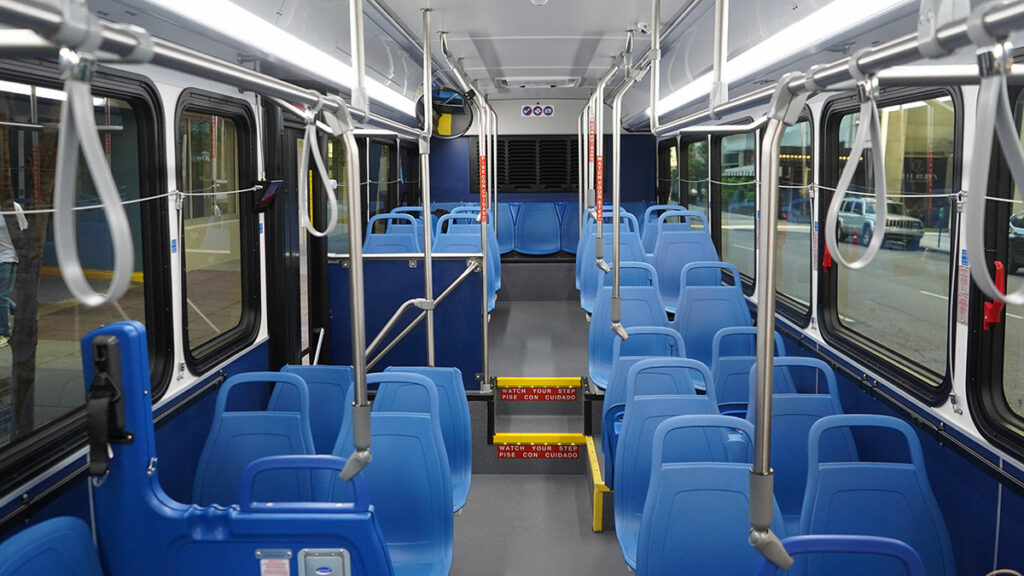Elevating Sanitation Standards: Metro’s Approach To Fleet Cleanliness During Ridership Growth And Service Expansion

While a daily cleaning addresses a significant portion of general cleaning tasks, each Metro bus undergoes a comprehensive “General Clean” twice a month, ensuring a top-to-bottom interior detail. (Photo courtesy of Metro)
By Jeff Mundstock, Metro Director of Fleet and Facilities
Over the past four years, service providers across various sectors have shared a common experience — the COVID-19 pandemic has profoundly elevated the importance of sanitation standards. With the widespread use of social media and instant access to information, any service is now subject to heightened scrutiny. The transit industry has been no exception to this trend and has needed to quickly adapt to meet the increased expectations of riders.
In the Cincinnati, OH, region, Metro’s service provides more than 13 million rides a year, making cleanliness of the entire fleet a top priority in ensuring the well-being and safety of passengers. Through the passage of a tax levy in 2020, voters placed a firm stamp of approval on their support for transit and the need to expand. With a goal of 20 million riders by 2026, and an increasing fleet, a systematic process has become vital to meet the standards and expectations of our community. While our method has seen an overwhelmingly positive outcome, it is important to note that the process Cincinnati Metro takes to keep up with demands is constantly evolving to meet the needs of our growing lines of service.
The first step in our process is a daily cleaning. As each bus completes its route and returns to the garage, it will receive a thorough sweeping to prepare for the next day. Additionally, any spills or spots are addressed during this process through spot mopping and cleaning. On the exterior of every bus, a manual scrubbing of the wheels and backs of the buses takes place, on top of the nightly washes each bus gets when it comes off the road.
While the daily cleaning will address a significant portion of general cleaning tasks, each bus undergoes a comprehensive “General Clean” twice a month, ensuring a top-to-bottom interior detail. A General Clean is a top-to-bottom interior cleaning which includes floor scrubbing, seat cleaning, window cleaning, interior ventilation cleaning, driver’s area cleaning including dashboard and operator controls, and the cleaning of all stanchions and surfaces. This process takes approximately four hours to complete per bus, with each team member handling two buses per shift.
Originally set on a monthly preventative maintenance schedule, adjustments were made due to updated route changes and increased annual mileage. A hybrid system now generates maintenance schedules based on time and/or mileage, aiming to perform General Cleans every 15 days or 3,000 miles, whichever occurs first.
To monitor the effectiveness of this process, a reporting system tracks the on-time performance of this preventative maintenance schedule. Our current on-time percentage is at 96.6 percent and every bus on average is General Cleaned every 2,791 miles. This tracking process has played a vital role in keeping the interior of our buses clean and ensuring that no buses are overlooked.
A final measure we introduced was in response to the COVID-19 pandemic. We’ve continued to perform a proactive measure of spraying each bus with an antimicrobial product after every General Clean. This solution forms a bacteriostatic barrier, offering protection for up to 90 days. To ensure complete coverage of each bus, electrostatic sprayers are utilized during this process.
As part of our sustainability initiatives, we have implemented several measures to minimize our impact on the environment. In fact, our washing system recycles its own water runoff and reuses up to 80 percent of the drain water. Additionally, most of our fleet consists of modern, fuel-efficient buses that help reduce greenhouse gas emissions and air pollutants.
The team at Metro is dedicated to an enjoyable rider experience with safety being the top priority. As we continue to expand our services, our process will continually be evaluated and updated to ensure that each vehicle meets the standards of the organization and our community.
Established in 1973 as a tax-funded, not-for-profit transportation provider by the Southwest Ohio Transit Authority, Metro is proud to celebrate 50 years of fixed-route, paratransit, and on-demand service to Hamilton County, Ohio. Visit go-metro.com.


